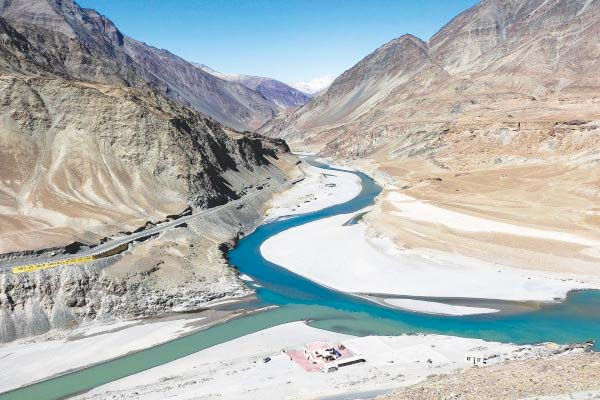Revisiting the Indus Waters Treaty: Water Diplomacy Amidst Growing Tensions
- Dr. Manisha Shrimali

- Sep 27, 2024
- 4 min read
Updated: Oct 21, 2024

September 19 marked the 64th anniversary of the Indus Waters Treaty, a testament to the fragile peace between India and Pakistan in a landscape marred by conflict. Signed in 1960, this landmark agreement governs the six rivers of the Indus basin, allocating 80% of the waters to Pakistan and leaving India with the remainder. Despite being hailed as a durable resolution to water disputes, the treaty faces challenges that threaten its sustainability.
As India’s population swells and its economy expands, so too does the demand for water, intensifying calls for a renegotiation of existing agreements, especially in the wake of the 2019 Pulwama attack. Yet, decades of mutual distrust continue to obstruct cooperation between the two nations. Before diverting water from the western rivers, India must prioritize addressing its infrastructure deficits to mitigate flooding risks in Jammu and Kashmir. In 2019, Nitin Gadkari issued a stark warning to Pakistan: cease its support for terrorism or face the consequences of diminished access to Indian waters. Concurrently, plans are in motion to redirect surplus water to Punjab and Haryana for agricultural use, alongside the construction of the Delhi-Amritsar-Katra Expressway, which promises to reduce travel time by four hours.
Pakistan’s mismanagement of water resources, particularly in Gilgit-Baltistan - a mineral-rich region, including gold - has relegated it to one of South Asia’s poorest areas. China’s encroaching influence, exemplified by the ambitious Diamer-Bhasha Dam, heightens India’s concerns. With an estimated cost of ₹442 billion, the dam has ignited protests in Gilgit, prompted by fears of submerged villages and demographic shifts. China’s hegemony over water resources complicates any potential renegotiation of the treaty. To maintain regional stability and protect its interests, India must also settle water disputes with neighbouring countries like Bangladesh and Nepal, thereby avoiding accusations of ‘water imperialism.’
Gilgit-Baltistan, a sparsely populated mountainous area over six times larger than Pakistan-occupied Jammu and Kashmir (PoJK), has been under Pakistan’s illegal control. The Indus River, which flows from Ladakh through PoJK, has been effectively commandeered. This resource-rich territory, abundant in minerals and precious metals, remains one of the poorest regions in South Asia. Notably, it is home to significant gold reserves, with mines scattered near Bashah, Braldo, Parkuta, Saltoro, and along the banks of the Indus and Shyok rivers.
The agriculturally fertile Shyok and Indus valleys produce a variety of crops, including rabi staples such as wheat, gram, peas, and rapeseed, alongside kharif crops like millets and buckwheat. Despite its agricultural potential, chronic mismanagement continues to stifle development in the region. Although it is legally part of India, Gilgit-Baltistan remains a hotspot for protests by marginalized communities, occasionally escalating into violence.
Divided into seven districts, this region is cradled by the Karakoram, Himalaya, and Hindukush ranges, bordering China’s Xinjiang, Afghanistan’s Wakhan Corridor, and Khyber Pakhtunkhwa. It encompasses eight of the world’s highest peaks and over fifty summits exceeding 7,000 meters. With elevations ranging from 300 to 28,250 feet, it is characterized by snow-clad peaks, vast glaciers, and lush valleys. Many of Pakistan’s freshwater resources originate in or traverse this area. The geopolitical importance of Gilgit-Baltistan has surged with the completion of the Karakoram Highway, which not only enhances trade with China but also solidifies the alliance between the two countries. This highway is vital for Pakistan’s freshwater supplies, which, under international law, legally belong to India. Despite this, successive Indian governments have maintained a conspicuous silence regarding developments in this strategically crucial region.
The looming threat of Chinese retaliation adds complexity to the renegotiation of the treaty. In the absence of water-sharing agreements, India and China are increasingly reliant on cross-border rivers like the Brahmaputra and Indus, both originating from Mount Kailash.
Since 1962, China has pursued control over key water bodies near Ladakh, including attempts to seize Pangong Lake and allegations of diverting the Galwan River, a tributary of the Indus. The Galwan flows from Samzungling in Aksai Chin, merging with the Shyok River near Leh. The Line of Actual Control (LAC) runs through this region, with disputes over its exact location, particularly around Pangong Lake, where India controls only 45 of its 135 kilometers. China’s construction of a road along the lake opposes India’s infrastructure developments. Tensions peaked on June 15, 2020, with a violent clash near Patrol Point 14 in the Galwan Valley, underscoring the need for India to resolve this issue to protect its natural resources.
China’s control over critical resources amid rising water scarcity poses a major challenge for India. The strategically important Kailash Range in Tibet was effectively closed off to India by China’s Assertion Line established on October 27, 1959, which diverges from the 1959 Claim Line near Black Top. Since 1962, the region has seen intense disputes. The 2017 Dawn leaks revealed China’s ambitions in Pakistan via the China-Pakistan Economic Corridor (CPEC) to dominate Indus basin agricultural resources, raising concerns that China may also try to control Tso Moriri, a glacial lake near Leh.
Population growth, climate change, and ineffective water management necessitate a shift towards improved technologies, crop diversification, and significant infrastructure investments. While India faces water-related accusations from Pakistan, Bangladesh, and Nepal, it retains its rightful claim to the waters of the Indus basin. India has fostered cooperative ties with Bhutan, as evidenced by successful hydropower initiatives. To ease regional tensions, India must navigate the delicate balance of avoiding ‘water imperialism’ while respecting the rights of its neighbours, necessitating diplomatic finesse and a commitment to water as a fundamental human right.
(The writer is an educationalist. Views personal.)





Comments